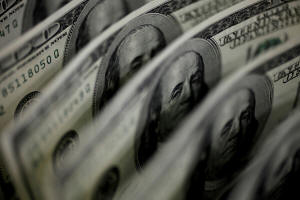Breakfast in, shopping out: tourists to the U.S. hit by soaring dollar
 Send a link to a friend
Send a link to a friend
 [September 29, 2022] By
Noel Randewich, John McCrank and Alun John [September 29, 2022] By
Noel Randewich, John McCrank and Alun John
SAN FRANCISCO/NEW YORK/LONDON (Reuters) -
In the weeks before heading to San Francisco for their vacation this
month, Jeff Skipper and his wife Valerie, from the United Kingdom,
watched helplessly as the U.S. dollar continued its meteoric rise
against the British pound.
The sterling/dollar exchange rate – which slumped to a record low this
week – has reduced the affordability of the already pricey Golden Gate
City for the couple, forcing them to economize on some holiday luxuries.
"The exchange rate has been the biggest topic of conversation since we
got here," said Jeff Skipper, 50, an electrician.
"Everything is pretty expensive for us," said Valerie, a 47-year old
university administrator.
"We've been buying food from grocery stores rather than having sit-down
meals because when you change it to the British amount, it doesn't seem
worth it. It's really a lot of money."
The pair are among droves of visitors to the United States feeling the
pinch of the mighty greenback, which scaled two-decade highs this month
driven partly by Federal Reserve interest rate hikes.

For British tourists in the United States, the pain of the rampant
dollar has been amplified by the collapse of the pound, which entered a
near free fall on Monday after the British government announced unfunded
tax cuts that sent investors fleeing.
Sterling hit a record low of $1.0327 on Monday, having plummeted 20%
against the dollar this year. It was trading just above that on
Wednesday at $1.0888.
"Now it's one dollar to the pound…It's really hit us," said Colin
Taylor, a retired telecoms engineer from the United Kingdom who was also
visiting San Francisco with his wife.
"We have breakfast and it's cost us 50 quid, 50 pounds, you know. And if
this were at home it would be 20 or 25 pounds. So it's a big, big jump
for us."
'TOO HIGH'
While the pound has experienced some of the most violent gyrations in
recent days, currency markets across the board have seen huge swings
amid increased geopolitical tensions and central bank rate hikes to tame
soaring inflation.
The relative strength of the U.S. economy has allowed the Fed to raise
rates more aggressively than its peers, however, pushing the dollar up
against the British pound, the euro and Japanese yen, as well as a slew
of smaller currencies.
The dollar index, which measures the greenback against a currency
basket, hit a fresh 20-year high of 114.78 on Wednesday.

[to top of second column] |

A picture illustration shows U.S.
100-dollar bank notes taken in Tokyo August 2, 2011. REUTERS/Yuriko
Nakao

"The dollar is too high. So we are spending, but not the way we
would like,” said Jose Alvado, a 48-year old public accountant from
Argentina who was visiting New York with his wife and two daughters.
"We are going to cheaper restaurants ... We go to the Disney store
and we don’t pick everything. We just take a look and then we go."
Still, with COVID-19 travel restrictions lifted, international
inbound U.S. leisure travel spending – adjusted for inflation – is
forecast to reach $87 billion this year compared with $33 billion in
2020 and 2021, and $145 billion in 2019, the U.S. Travel Association
said in June.
And some tourists say they will not let the dollar's strength spoil
their fun.
"I have to enjoy New York," said Gilles Nolorgues, 48, an app
designer from Paris.
'MONOPOLY MONEY'
For travelers outside the United States with dollars in their
pocket, the spending is easy.
With the dollar and the euro reaching parity for the first time in
20 years in July, American tourists have been splurging on luxury
goods in Paris as well as enjoying cheaper treats in London's West
End, Reuters has reported. [L1N30X1E5]
Americans are spending 11% more on domestic and overseas travel in
2022 compared with 2019, according to consumer survey data gathered
by the American Society of Travel Advisors, a trade organization.
"It feels like we're spending Monopoly money," said Ike Armstrong,
26, from California, speaking near London’s Trafalgar Square.
In Bali, Indonesia, 39-year old Johnny Follin from Los Angeles,
California, said the strong dollar had allowed him to indulge more
on good food, drinks and massages than he would have otherwise. The
U.S. dollar has risen about 7% on the Indonesian rupiah this year.

“(For) bringing U.S. dollars here, it's the best time in ages,” said
Paul Spight from behind the counter of his currency exchange in
Wollongong, south of Sydney, Australia.
The U.S. dollar is up about 10% on the Aussie this year. “That
really helps the spending power coming in,” Spight added.
(Reporting by Noel Randewich in San Francisco, John McCrank in New
York, Alun John in London, Ananda Teresia in Jakarta and Tom
Westbrook in Sydney; writing and additional reporting by Michelle
Price; editing by Deepa Babington)
[© 2022 Thomson Reuters. All rights
reserved.]
This material may not be published,
broadcast, rewritten or redistributed.
Thompson Reuters is solely responsible for this content. |